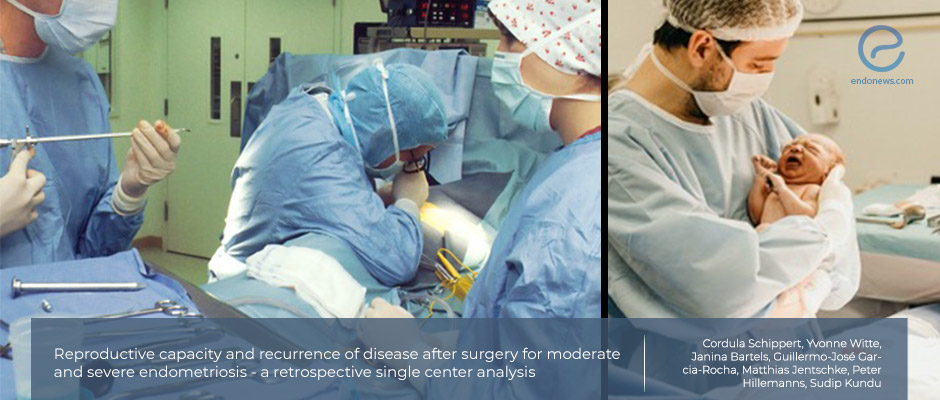Reproductive capacity and recurrence rate after surgery for Stage III/IV endometriosis
Aug 5, 2020
Individualized therapy, to preserve fertility and to decrease the risk of recurrence can be promising for patients with moderate or severe endometriosis.
Key Points
Highlight:
- The personalized surgery and complete excision of endometriosis improve fertility rates and endometriosis-related symptoms.
Importance:
- 50 percent of endometriosis patients have infertility and almost 50 percent of the infertile women are diagnosed with endometriosis.
- The known recurrence rate after endometriosis surgery is up to 67 percent after 5 years.
What is done here:
- To analyze the recurrence and pregnancy rates following surgical resection of stage III/IV endometriosis, 456 advanced-stage endometriosis patients were selected.
- An e-mail including a questionnaire related to postoperative medical treatment, pregnancies, relief of symptoms, and recurrence was sent.
- Responses of 206 patients (45.2%) were analyzed.
- Known facts are:
- Universally accepted first-line therapy is the surgical removal of endometriosis lesions to help reducing pain and improving fertility.
- The main treatment goal is the removal of all the visible lesions, in peritoneal endometriosis.
- ESHRE guidelines recommend laparoscopic resection of lesions to improve the pregnancy rate in advanced stage endometriosis for women with infertility.
- In severe endometriosis cases with marked adhesions, tubal pathology, or recurrence, even a laparotomy can be indicated.
Key results:
- Relief in complaints was achieved in 93.2 percent of the patients and the recurrence rate was found to be 21.8 percent
- A higher risk to develop recurrence was an age younger than 35 (p < 0.005).
- 65 percent of patients who wished to have children became pregnant after surgery.
- Around 8% of the patients (17/206) required intestinal and bladder surgery.
- Postoperative pharmacological therapy was prescribed to almost half of the patients (106/206) for an average of 26.9 months. The other half did not receive postoperative pharmacological therapy due to tan active desire to have children directly after surgery.
- The postoperative pregnancy rate was statistically higher for patients younger than 35y.
Limitations of the study:
- The study was conducted in a retrospective manner.
- Patients with early disease were not included in this study.
Lay Summary
If gaining fertility back is the main goal, the surgical removal of endometriosis lesions is globally recognized as first-line therapy. Even though, pre- and postoperative hormone therapy leads to a significant decrease in the spread of the disease measured with the revised ASRM scores it is not an option for fertility preservation.
In the study conducted in Hannover Medical School, the authors aimed to establish postoperative recurrence and pregnancy rates in patients after surgical resection of moderate and severe endometriosis lesions (rASRM stage III and IV). This was performed with data analysis and survey results of patients who underwent surgery between 2004 and 2014 at their hospital.
Indications for the operation were determined as typical endometriosis symptoms, sonographic findings (e.g., ovarian cysts), and/or infertility. A survey was prepared to reach out to answer for the following items: Postoperative relief of symptoms, the presence of a postoperative pharmacological therapy; the development of a recurrence requiring repeated surgery. If the patients had the desire to have children postoperatively, preoperative pregnancies and deliveries, as well as postoperative pregnancies, the type of delivery and outcome regarding the child was questioned.
More than forty-five percent of the patients responded to the survey. Personalized surgery was performed aiming total removal of each lesion and fertility preservation. When an incomplete resection was applied, 41.5 percent (5/12) of women became pregnant, however, 68.5 percent (74/180) of women were able to conceive after complete surgical excision. Also, after complete resection, lesser complications, higher postoperative relief -by more than 90%, and a low rate of recurrence were achieved.
The study found 65.8 percent of women became pregnant after the excision of moderate or severe endometriosis lesions.
The results of the study show that individualized therapy concepts to preserve fertility and to decrease the risk of recurrence can be promising for patients with moderate or severe endometriosis.
Research Source: https://pubmed.ncbi.nlm.nih.gov/32660473/
Stage III endometriosis stage IV endometriosis classification Severe endometriosis Recurrence Pregnancy rate

